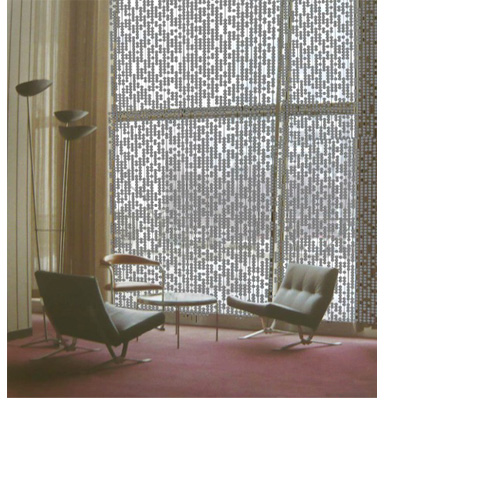
Hella Jongerius and Rem Koolhaas to design United Nations delegates lounge
Dezeen Wire: a team of Dutch designers including Hella Jongerius, architect Rem Koolhaas and graphic designer Irma Boom have been selected to re-design the North Delegates’ Lounge at the United Nations headquarters in New York.
The interior will mix classic Dutch and international furniture with pieces designed specially for the lounge.
A curtain with 30,000 partly-glazed porcelain beads will be manufactured by Dutch craftsmen while a large knotted curtain will screen windows on the north facade.
Here are some more details from Hella Jongerius:
U.N. North Delegates’ Lounge
RE– captures the content of the re-design of the North Delegates’ Lounge, which is based on a careful ‘editing’ of the history of the lounge. Existing designs alternate with new designs. Monumental architectonic interventions alternate with ample attention for material details, tactility and colors.
The re-design of the Delegates’ Lounge, one of the most prestigious spaces in the United Nations headquarters in New York, has been adopted by the Netherlands. The donation is part of a tradition. The U.N. headquarters were originally completed in 1952 and financed in part by donations from the member states. Between 2009 and 2013 the buildings are being renovated and the U.N. has asked member states to adopt spaces, in return for which they may provide the renovation design.
After a selection process, in which four Dutch design teams competed with each other, the team assembled by Hella Jongerius was selected. The design team is composed of:
● Hella Jongerius, designer
● Rem Koolhaas/OMA, architect
● Irma Boom, graphic designer
● Gabriel Lester, artist
● Louise Schouwenberg, theorist
The North Delegates’ Lounge is used as a meeting place for thousands of policymakers and diplomats of the 192 member states. It has a key role in the way the U.N. works, as it is an unofficial space where conversation is unrecorded, informal. While all major decisions are taken in other spaces, here many ‘deals’ between nations are actually closed. Friendships are born, or renewed, and animosities are assuaged.
The Dutch design team has explicitly taken into account factors that are of great importance in this context, such as the conventions that apply here, functionality, comfort, timelessness, calm, and safeguarding the privacy of the delegates while facilitating encounters. The team has also taken into account the original design and furnishing of the North Delegates’ Lounge and the changes that it has undergone since 1952.
The mezzanine, a 1979 addition to the lounge, is removed, restoring the original design of the North Delegates’ Lounge. The existing artworks are re-located with a contemporary gesture: by placing them slightly apart from an aluminum wall a glimpse on their backsides is offered. Some furniture items have survived, such as the Peacock Chair, and are mixed with new designs that offer solutions for the special conditions of this space, such as the RE-Lounge Chair and the Bubble Desk. Re-interpretations of Dutch design classics, including a design by Rietveld, alternate with re-interpretations of international designs, including a design by Prouvé. In the entrance area a sophisticated digital information device (e-paper) offers a variety of information. A handcrafted curtain (Knots&Grid) is hung tight in front of the slanted windows of the North façade; it carries many references, including Dutch maritime history. The East façade curtain (Knots&Beads) consists of 30.000 partly glazed porcelain beads; the beads are handcrafted by Dutch craftsmen and bring literally a piece of the Netherlands to the U.N.
In 1952 11 architects of the U.N. Headquarters, including Wallace K. Harrison, Le Corbusier, and Oscar Niemeyer, succeeded in creating a superb work, in which their individual wishes merged in a creation of great smoothness. The Dutch team, aware of this tradition, has also worked together on all its plans. The various interventions are linked to specific names, whose voices were prevalent in the final designs. However, until the final moment all interventions have been open to debate and questioning by all the other members of the team. The result is a multidisciplinary Gesamtkunstwerk that puts the Dutch creative industry in the international spotlight, and offers both old and new perspectives on ‘A Workshop For Peace’ (the expression architect Wallace K. Harrison used to describe both the design process of the U.N. buildings and the global organization itself).